In the culinary world, where creativity dances with tradition, and innovation sizzles alongside convention, one question ignites a flame of curiosity: can you put a pan on a grill? Picture the scene: a backyard barbecue, the air thick with anticipation and the aroma of grilling delights.
As the grill master expertly tends to the flames, thoughts wander to the endless possibilities of what could sizzle atop those fiery grates. But what if we dared to defy the norms, to challenge the boundaries of grill-dom, and introduce the humble pan to this smoky symphony?
Brace yourselves, for we’re about to embark on a culinary adventure where the grill becomes not just a vessel for charred perfection but a stage for boundless experimentation. So, grab your spatula, don your apron, and let’s explore the tantalizing world of putting a pan on a grill.
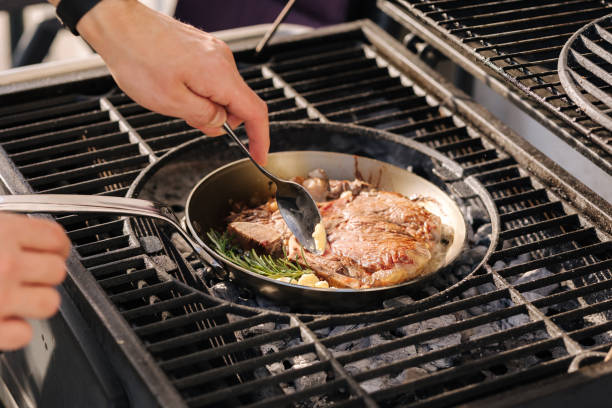
Can You Put A Pan On A Grill?
Yes, you can indeed put a pan on a grill, and it’s a common practice in outdoor cooking. Using a pan on a grill opens up a world of possibilities for preparing a wide variety of foods, from vegetables and seafood to meats and even desserts.
Whether you’re looking to sauté veggies, sear a steak, or bake a cake, a pan on the grill offers versatility and control over the cooking process. It’s important to choose a pan that can withstand high heat, such as cast iron or stainless steel, to ensure even cooking and prevent warping.
Using a pan on the grill allows you to capture those delicious smoky flavors while maintaining the convenience and ease of indoor cooking. Just be sure to monitor the temperature and adjust as needed to achieve the desired results, as grills can vary in heat intensity.
Overall, utilizing a pan on the grill adds another dimension to your outdoor culinary repertoire, enabling you to create flavorful dishes with a hint of that classic grilled taste.
Types Of Grills
There are several types of grills available on the market, each offering unique features and cooking methods to suit different preferences and needs:
Charcoal Grills
Charcoal grills are iconic for their ability to infuse food with a rich, smoky flavor that many grill enthusiasts adore. They operate by burning charcoal briquettes or lump charcoal as fuel, typically placed in a firebox beneath the cooking grate.
Charcoal grills come in various shapes and sizes, ranging from classic kettle grills to larger barrel-shaped smokers. One of the main appeals of charcoal grills is their simplicity; they have fewer mechanical components than gas or electric grills, making them easy to operate and maintain.
However, mastering the art of charcoal grilling requires some skill, as it involves managing airflow and temperature to achieve the desired level of heat for cooking. Some charcoal grills feature adjustable vents or dampers to control airflow, allowing users to regulate the intensity of the fire.
Charcoal grills are often preferred for their ability to reach high temperatures, making them ideal for searing steaks or achieving a crisp crust on meats. Despite their rustic charm and flavor-enhancing capabilities, charcoal grills can be more time-consuming to start and require more cleanup than gas or electric grills due to ash residue.
Nonetheless, for many grill enthusiasts, the ritual of firing up a charcoal grill and tending to the flames adds to the overall cooking experience, making charcoal grills a beloved choice for outdoor cooking aficionados.
Gas Grills
Gas grills are renowned for their convenience, ease of use, and precise temperature control, making them a popular choice among grillers of all skill levels.
Powered by propane or natural gas, these grills heat up quickly and eliminate the need for charcoal or wood, offering a hassle-free grilling experience. Gas grills typically feature multiple burners that can be individually controlled, allowing users to adjust the heat to different cooking zones on the grill surface.
This versatility enables users to simultaneously cook various foods at different temperatures, making gas grills ideal for grilling everything from delicate vegetables to thick cuts of meat.
Moreover, many gas grills come equipped with additional features such as side burners, rotisserie kits, and smoker boxes, further expanding their culinary capabilities. Another advantage of gas grills is their relatively straightforward cleanup process, as they produce minimal ash compared to charcoal grills.
Gas grills often feature easy-to-clean cooking grates and drip trays, simplifying maintenance and upkeep. While gas grills lack the characteristic smoky flavor imparted by charcoal grills, some models offer smoker boxes or flavorizer bars to infuse food with a hint of smokiness.
Overall, gas grills excel in convenience, versatility, and efficiency, making them an excellent choice for busy grillers who prioritize convenience without sacrificing performance or flavor.
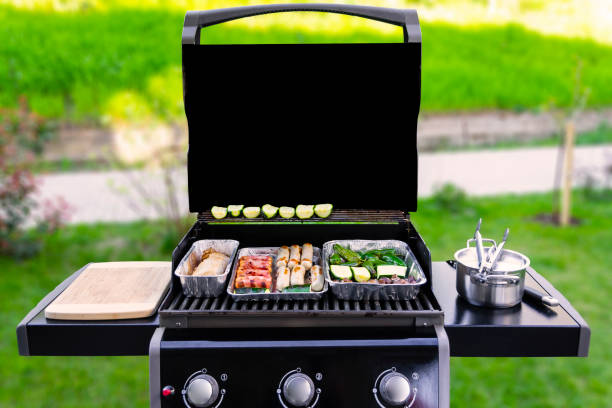
Electric Grills
Electric grills are highly convenient cooking appliances that offer a simple and efficient way to grill indoors or in spaces where open flames are not permitted. Powered by electricity, these grills heat up quickly and evenly, providing a consistent cooking experience without the need for charcoal, propane, or natural gas.
One of the primary advantages of electric grills is their versatility and suitability for use in various environments, including apartments, balconies, and even indoors.
They produce no open flames or harmful emissions, making them a safer option for indoor grilling compared to traditional charcoal or gas grills. Electric grills often feature adjustable temperature controls, allowing users to customize the heat level according to their cooking preferences.
Some models even offer options for griddling, searing, or smoking, providing users with a wide range of cooking possibilities beyond traditional grilling. Another benefit of electric grills is their ease of use and cleanup.
With no charcoal ash or gas tanks to deal with, maintenance is minimal, and many electric grills feature removable cooking plates or grates that are dishwasher safe for effortless cleaning.
While electric grills may not impart the same smoky flavor as charcoal or gas grills, they are an excellent option for those seeking a convenient and fuss-free grilling experience without compromising on taste or quality.
Whether you’re grilling indoors, on a small patio, or in a location where open flames are prohibited, electric grills offer a practical solution for enjoying grilled foods year-round.
Pellet Grills
Pellet grills offer a unique grilling experience that combines the convenience of gas grills with the flavorful results of cooking over wood pellets. These grills utilize compressed wood pellets as fuel, which are automatically fed into a fire pot by an electric auger.
This innovative design allows for precise temperature control, making pellet grills ideal for a wide range of cooking techniques, including grilling, smoking, roasting, baking, and barbecuing.
One of the key advantages of pellet grills is their versatility, allowing users to achieve consistent results across different types of food. The use of wood pellets imparts a distinct smoky flavor to grilled dishes, enhancing the overall taste and aroma.
With features like digital temperature controllers and Wi-Fi connectivity for remote monitoring and control, pellet grills offer convenience and ease of use, making them a popular choice among outdoor cooking enthusiasts looking to elevate their grilling game.
Kamado Grills
Kamado grills, inspired by traditional Japanese clay cooking vessels, have gained popularity for their exceptional heat retention and versatility in outdoor cooking.
Made from ceramic or other heat-retaining materials, Kamado grills excel at maintaining consistent temperatures, making them ideal for both low-and-slow smoking and high-temperature grilling.
Their egg-shaped design allows for efficient airflow control, enabling users to adjust the grill’s temperature with precision. Kamado grills are renowned for producing juicy, flavorful meats and achieving impressive sear marks on grilled dishes.
Their versatility extends to baking and roasting, with many users successfully using them for pizzas, bread, and even desserts. While Kamado grills tend to come with a higher price tag, their durability, efficiency, and ability to deliver restaurant-quality results make them a worthy investment for serious grill enthusiasts.
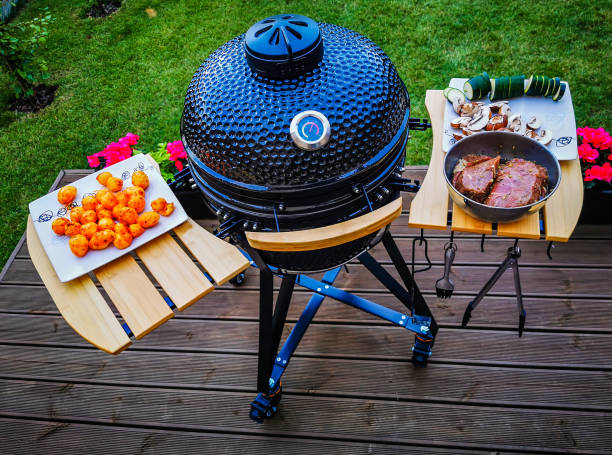
Portable Grills
Portable grills are compact, lightweight cooking devices designed for on-the-go grilling adventures. Whether you’re camping, picnicking, tailgating, or simply enjoying a day at the beach, portable grills offer the convenience of outdoor cooking without the need for bulky equipment.
These grills come in various sizes and fuel types, including charcoal, gas, and electric, catering to different preferences and needs. Despite their smaller footprint, portable grills often feature foldable legs, carrying handles, and lightweight materials for easy transport and storage.
Some models even come with disposable propane canisters or compact charcoal trays, further enhancing their portability. Despite their compact size, portable grills deliver impressive performance, allowing users to grill everything from burgers and hot dogs to kebabs and veggies with ease.
Whether you’re a seasoned outdoor enthusiast or a casual griller, portable grills are a convenient and versatile solution for enjoying delicious grilled meals on the go.
Hybrid Grills
Hybrid grills offer the best of both worlds by combining multiple fuel types, such as gas, charcoal, or pellets, into a single cooking appliance. This innovative design provides users with the flexibility to choose their preferred cooking method for different dishes or occasions.
Hybrid grills typically feature separate cooking chambers or compartments for each fuel type, allowing users to easily switch between gas, charcoal, or pellets based on their cooking needs.
With the ability to grill, smoke, roast, and barbecue, hybrid grills offer unmatched versatility and convenience, catering to a wide range of culinary preferences. Whether you crave the convenience of gas grilling, the smoky flavor of charcoal, or the precision of pellet cooking, hybrid grills provide the ultimate solution for outdoor cooking enthusiasts seeking maximum flexibility and flavor.
The Role of Pans in Grilling
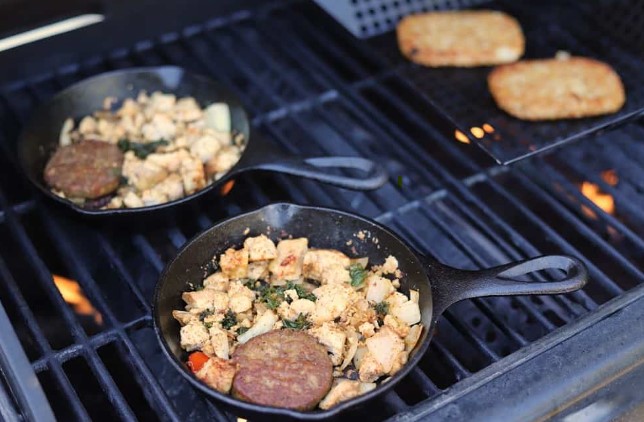
Pans play a versatile and crucial role in grilling, offering a range of cooking options beyond traditional grilling methods. While grilling typically involves cooking food directly over an open flame or heat source, pans allow for more controlled and diverse cooking techniques, expanding the possibilities for outdoor culinary creations.
One primary function of pans in grilling is to contain and cook foods that may otherwise fall through the grill grates, such as smaller vegetables, delicate seafood, or finely chopped ingredients.
Pans provide a stable cooking surface, preventing food from coming into direct contact with the flames or heating elements while still allowing for that characteristic grilled flavor to infuse the dish.
Pans enable grilling enthusiasts to experiment with different cooking methods, such as sautéing, stir-frying, or even baking, right on the grill. This versatility allows for the preparation of a wide range of dishes, from grilled vegetables and shrimp stir-fries to skillet desserts like cobblers or crisps.
Furthermore, pans can be used to catch drippings from grilled meats, preventing flare-ups and minimizing the risk of charring or burning. By placing a pan beneath the grill grates, chefs can collect flavorful juices for basting or sauce-making, enhancing the overall taste and moisture of grilled dishes.
Overall, pans serve as invaluable tools in the griller’s toolkit, offering flexibility, control, and creativity in outdoor cooking. Whether used to grill, sauté, bake, or collect drippings, pans play an essential role in elevating the grilling experience and expanding the culinary possibilities over an open flame.
Why Would You Want To Put A Pan On A Grill?
There are several reasons why you might want to put a pan on a grill:
Versatility
Using a pan on a grill adds versatility to your outdoor cooking repertoire. While grilling typically involves cooking food directly over open flames, incorporating a pan allows for a broader range of culinary techniques.
You can sauté vegetables, sear meats, simmer sauces, fry eggs, or even bake desserts right on the grill. This versatility enables you to prepare a diverse array of dishes, from stir-fries and paellas to frittatas and grilled pizzas.
Whether you’re craving grilled classics or exploring new flavors and cuisines, using a pan on the grill opens up endless possibilities for creative and delicious outdoor cooking experiences.
Controlled Cooking
Using a pan on a grill provides precise control over the cooking process, particularly for foods that require more delicate handling or precise temperature regulation.
Unlike cooking directly on grill grates, where food can be exposed to direct flames and varying heat levels, using a pan allows for a more controlled cooking environment. This is especially beneficial for foods like seafood, vegetables, or smaller cuts of meat that might be prone to overcooking or falling apart on a traditional grill.
With a pan, you can adjust the heat distribution and cooking time to ensure that your dishes are cooked evenly and to your desired level of doneness. Using a pan on the grill minimizes the risk of flare-ups and charred spots, resulting in perfectly cooked, flavorful meals every time.
Preventing Flare-ups
Using a pan on a grill can help prevent flare-ups, which occur when fat or juices from food drip onto the flames, causing sudden bursts of fire.
Placing a pan on the grill provides a barrier between the food and the flames, reducing the likelihood of flare-ups. This is particularly useful when grilling fatty meats or marinated foods that are prone to dripping liquids.
By containing these drippings in the pan, you can minimize the risk of charring or burning your food, ensuring that it cooks evenly and retains its moisture and flavor.
Preventing flare-ups creates a safer grilling environment, reducing the risk of accidents or injuries caused by sudden bursts of flames. Overall, using a pan on the grill helps to maintain more consistent and controlled cooking conditions, resulting in better-tasting and safer grilled dishes.
Collecting Juices
Using a pan on a grill allows for the collection of flavorful juices and drippings from grilled meats and vegetables. These juices contain valuable flavor components and can be used to enhance the taste and moisture of your dishes.
By placing a pan beneath the food being grilled, you can capture the juices as they drip down, preventing them from evaporating or causing flare-ups on the grill grates.
These collected juices can then be utilized in various ways, such as for basting meats, making sauces, or adding depth of flavor to side dishes. Incorporating these juices into your cooking not only maximizes flavor but also reduces waste, ensuring that every delicious drop is put to good use.
Whether you’re grilling steaks, chicken, or vegetables, using a pan to collect juices adds an extra layer of richness and complexity to your outdoor cooking experience.
Convenience
Using a pan on a grill adds a layer of convenience to outdoor cooking. It allows for easier cleanup since food is contained within the pan, preventing it from sticking to the grill grates and making them difficult to clean.
Using a pan can simplify the cooking process, especially for dishes that require more attention or involve multiple ingredients. For example, you can prepare complete meals in one pan, such as cooking vegetables alongside proteins or creating one-pan dishes like stir-fries or paellas.
This reduces the need for multiple pots and pans, streamlining the cooking process and minimizing the amount of equipment needed.
Furthermore, using a pan on the grill provides flexibility in terms of cooking location, allowing you to grill in places where traditional grilling methods may not be feasible, such as on a camping trip or in a small outdoor space.
Overall, incorporating a pan into your grilling routine adds convenience and simplicity while still allowing you to enjoy delicious grilled meals with ease.
Other Things You Might Want To Keep In Mind
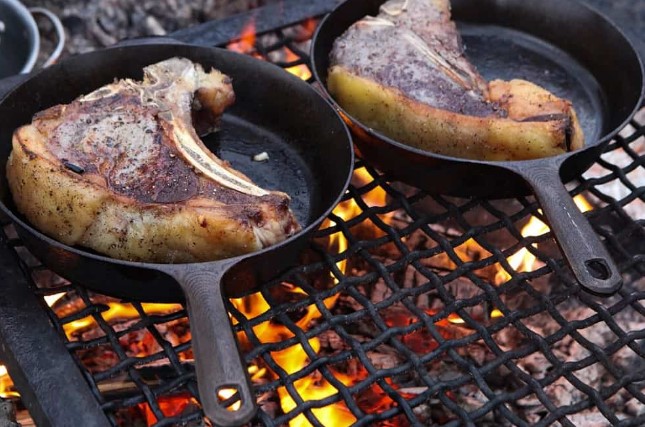
Now you know how grills and pans go together. Let’s discuss a few things you should be aware of in the kitchen in this section.
Not Everything Would Work Together
Indeed, not all ingredients or dishes are suitable for cooking together in a pan on the grill. It’s important to consider factors such as cooking times, temperatures, and flavor compatibility when selecting ingredients to cook together.
For example, delicate vegetables may cook much faster than dense cuts of meat, leading to uneven results if cooked together in the same pan. Certain ingredients may release liquids during cooking, which can affect the texture and flavor of other ingredients in the pan.
To ensure successful cooking, it’s best to choose ingredients that have similar cooking times and characteristics or to cook different components separately before combining them. This allows you to control the cooking process more effectively and achieve optimal results with each ingredient.
Try And Try
When experimenting with using a pan on the grill, it’s essential to embrace a mindset of trial and error. Not every dish or cooking method will yield perfect results on the first try, and that’s okay.
Grilling is as much about the process of learning and refining techniques as it is about enjoying the end result. So, don’t be afraid to try new ingredients, combinations, and cooking methods, even if they don’t turn out perfectly the first time.
Use each experience as an opportunity to learn and improve, adjusting your approach based on what works and what doesn’t.
With persistence and a willingness to experiment, you’ll gradually develop a repertoire of grilled dishes that suit your tastes and preferences, making every cooking session on the grill a rewarding and enjoyable experience.
Adjustments
Making adjustments is a crucial aspect of successful grilling with a pan. Since every grill and cooking situation is unique, it’s essential to be prepared to adjust your cooking technique as needed throughout the grilling process.
This might involve tweaking the temperature settings, shifting the placement of the pan on the grill to avoid hot spots, or modifying the cooking time based on how the ingredients are progressing.
Be open to making adjustments to the ingredients themselves, such as seasoning levels, ingredient combinations, or cooking methods, to achieve the desired outcome.
By staying flexible and willing to make changes on the fly, you can adapt to any challenges or unexpected developments that arise during the grilling process, ensuring that your dishes turn out delicious every time.
Frequently Asked Questions (FAQs) – Pan On A Grill
Can I place a pan directly on the grill?
Absolutely! Placing a pan on the grill is a fantastic way to expand your cooking options and infuse your dishes with delicious smoky flavor.
Is it safe to use a pan on the grill?
Yes, it’s perfectly safe to use a pan on the grill, as long as you follow proper precautions and use cookware that is suitable for grilling.
What types of dishes can I cook in a pan on the grill?
The possibilities are endless! You can cook everything from juicy steaks and succulent seafood to crispy veggies and even delicate desserts in a pan on the grill.
Will using a pan on the grill affect the taste of my food?
Absolutely! Cooking with a pan on the grill allows your food to absorb delicious smoky flavors, enhancing its taste and giving it that authentic grilled taste.
Can I use any type of pan on the grill?
While not all pans are suitable for grilling, there are plenty of options available that are specifically designed for use on the grill, ensuring optimal performance and safety.
How do I properly care for my pans when using them on the grill?
To keep your pans in top condition, make sure to clean them thoroughly after each use and avoid using abrasive cleaners that could damage their surface.
Can I use a pan on the grill for cooking multiple dishes at once?
Absolutely! Using a pan on the grill allows you to cook multiple dishes simultaneously, making it perfect for entertaining or preparing meals for large gatherings.
Will using a pan on the grill save me time and effort?
Definitely! Cooking with a pan on the grill is not only convenient but also saves you time and effort, as it eliminates the need for additional cookware and simplifies the cooking process.
Can I achieve restaurant-quality results by using a pan on the grill?
Without a doubt! Cooking with a pan on the grill allows you to achieve professional-level results, ensuring that your dishes are cooked to perfection every time.
How can I get started with using a pan on the grill?
Getting started is easy! Simply select a high-quality pan that is suitable for grilling, preheat your grill to the desired temperature, and get ready to unleash your culinary creativity!
Conclusion
In conclusion, the question of whether one can put a pan on a grill is contingent upon several factors, including the type of grill, the material and design of the pan, and the intended cooking method.
While it is generally possible to use a pan on a grill for certain cooking tasks such as sautéing vegetables or searing meats, caution must be exercised to ensure safety and optimal results.
Utilizing appropriate cookware, considering heat distribution, and regulating temperatures carefully can facilitate successful grilling with a pan.
Ultimately, experimentation and familiarity with one’s equipment are key to mastering the art of grilling with a pan, offering versatility and expanding culinary possibilities for outdoor cooking enthusiasts.